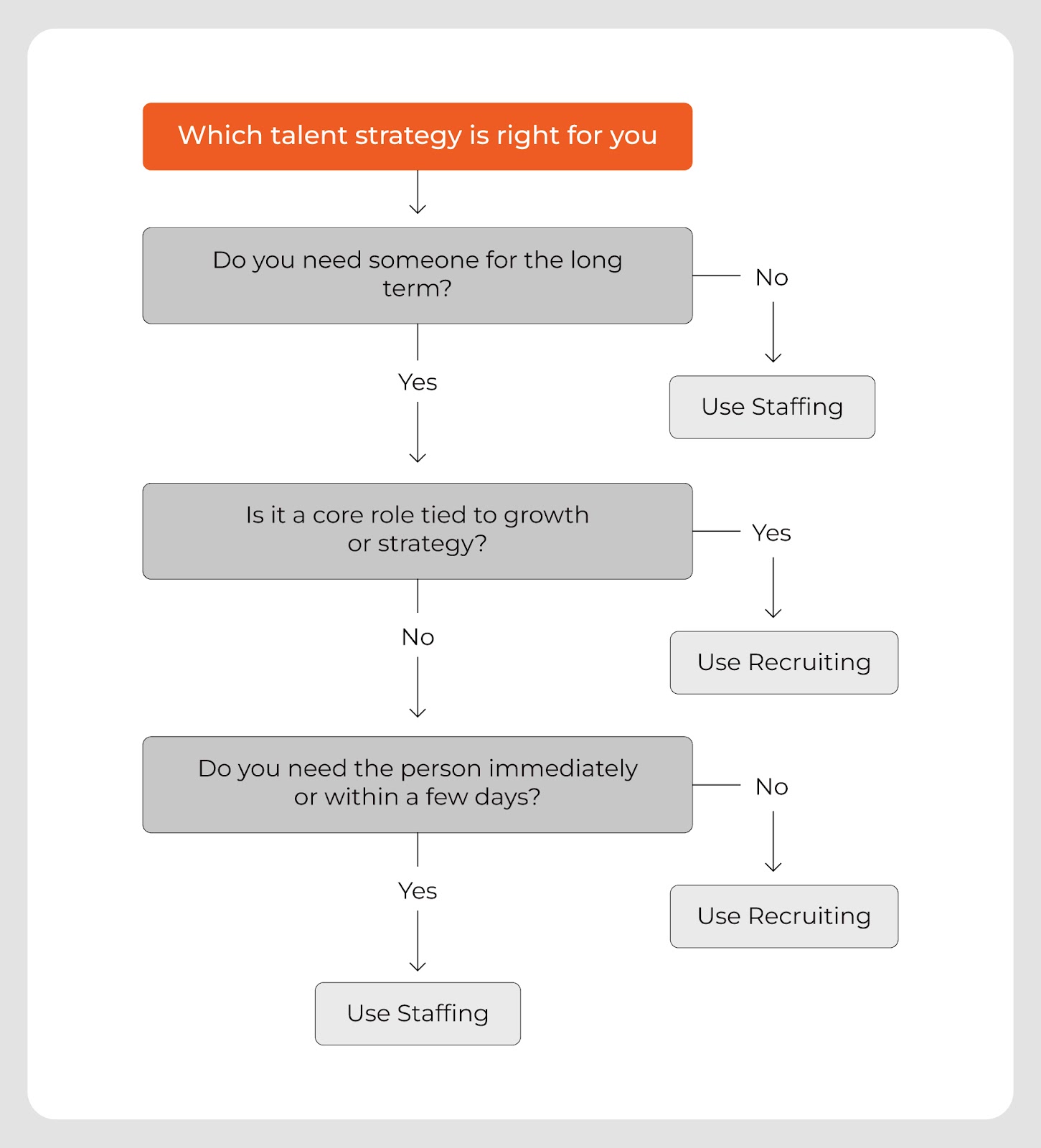What comes to mind when you think about staffing and recruiting? Do they seem like two terms for the same thing?
That’s a very common misconception!
While many organizations continue to use the terms interchangeably, they represent distinct processes that play different roles in workforce management. Treating them as synonymous can lead to poor workforce planning, inflated costs, and underperforming hires.
Today’s dynamic work culture requires an agile and cost-effective workforce strategy that aligns with the broader business goals. If you are working toward the same, it’s important to understand the differences between staffing vs. recruiting.
This goes beyond just roles filled; it’s about how your organization responds to change, builds resilient teams, and scales without compromising performance or company culture.
Understanding Recruitment and Staffing
Recruiting – A strategic approach to long-term talent acquisition
Recruiting is a holistic and strategic process. It involves identifying, attracting, evaluating, and onboarding candidates who can truly contribute, whether it is for contracts or permanent roles within an organization.
Modern recruiting is inherently aligned with business goals, focusing on continuity, succession planning, and growth. The aim is to find qualified candidates whose skills, values, and potential align with the company’s direction.
Typically, recruiting involves:
- Workforce planning based on long-term capability needs
- Cultural alignment and leadership potential as key evaluation factors
- Structured employer branding to attract the right kind of talent
- Full-time roles that are important to ongoing business success
When done well, recruiting has a cumulative impact. It improves retention, enhances internal mobility, and reduces the cost of mis-hires over time.
Staffing – Tactical resourcing for immediate business needs
Staffing is a fast-paced, tactical approach to fulfill short-term, project-based, or high-volume talent needs. It’s ideal when the goal is to quickly fill roles and maintain operational continuity, often under tight timelines or peak demand periods.
In contrast to recruiting, which focuses on long-term team planning, alignment, and business impact, irrespective of whether the role is full-time or contract, the staffing model emphasizes speed and adaptability.
Organizations often partner with staffing services companies like SPECTRAFORCE to streamline this process when internal resources or timelines make recruitment cycles impractical.
Staffing allows for:
- Minimizing idle time and unproductive roles
- Avoiding long-term headcount commitments
- Filling skill gaps without permanent onboarding
Staffing as a workforce strategy is essential in industries with high variability, such as healthcare, logistics, manufacturing, or IT services.
Staffing vs. Recruiting: The Key Differences
| Aspect | Recruiting | Staffing |
| Duration of Employment | Typically long-term or permanent roles that support strategic, ongoing needs | Short-term, contract-based, or project-specific roles with defined timeframes |
| Objective | To build a stable, scalable workforce aligned with long-term business goals | To provide flexibility and speed to meet immediate or fluctuating talent needs |
| Process | Structured hiring pipelines, employer branding, and long-term talent development | Rapid deployment via staffing agencies with pre-vetted candidate pools |
Advantages and Disadvantages of Recruiting and Staffing
Both staffing and recruiting are important elements in a workforce strategy. But they are not interchangeable. Each brings distinct advantages and trade-offs, depending on the hiring context, timeline, and long-term business goals.
Here are the advantages and disadvantages of each:
Recruiting
Recruiting supports long-term workforce needs. It’s a strategic approach used when roles demand sustained contribution, alignment with company goals, and potential for growth.
Unlike staffing, which focuses on speed and volume, recruiting emphasizes finding the right fit for roles that shape business direction, whether they are full-time or contract-based.
Advantages:
- Cultural continuity:
Recruited talent, whether on contract or full-time, is carefully matched to your organization’s values and mission. This leads to stronger cultural alignment and more cohesive teams over time.
- Skill development and retention: Strategic hires are more likely to grow with the company, upskill, and take on leadership opportunities—reducing rehiring costs and knowledge gaps in the long run.
- Team stability: Whether it’s a senior contract consultant or a full-time product manager, recruiting focuses on roles that drive consistency, accountability, and long-term success.
Disadvantages:
- Longer time-to-hire: The process is often slower due to detailed screening, internal approvals, and negotiation cycles.
- Higher upfront cost: Salaries, onboarding, and benefits can significantly increase cost per hire, especially if the fit isn’t right.
- Reduced agility: Permanent headcount adds rigidity. It is harder to downsize or reassign without legal and cultural friction.
Staffing
Staffing helps businesses stay productive when timelines are tight or demand is volatile. If your goal is coverage, not continuity, it is ideal to go for the staffing model.
Advantages:
- Faster time to hire: Staffing companies provide pre-vetted candidates, reducing sourcing and evaluation time drastically.
- Lower commitment and cost: No long-term benefits, equity, or internal training investment, just skill on demand.
- Operational flexibility: Temporary roles are easier to scale up or wind down. You get exactly what you need, when you need it.
Disadvantages:
- Lower engagement: Temporary workers may not be as emotionally invested or aligned with long-term company goals.
- Increased churn: High turnover can create inconsistency and strain for permanent teams managing short-term staff.
- Onboarding burden: Even for short-term hires, repeated onboarding cycles drain time and attention from core operations.
Which Talent Strategy Is Right for You?
There’s no good or bad approach between staffing and recruiting. The right choice depends on what your business needs now and what you’re planning for next.
Here’s when each model delivers the most value.

When to opt for recruiting
Recruiting makes sense when you’re investing in long-term stability, growth, and culture. When the cost of a mis-hire is high, recruiting is worth the time and investment. Scenarios like:
- Filling core positions that are critical to your company’s success. Think leadership, product development, client-facing strategy, or compliance.
- Building specialized teams where the learning curve is steep and the work requires deep domain knowledge or proprietary training.
- Reinforcing culture and values by bringing in people who’ll grow with the company and shape its internal dynamics over time.
When to opt for staffing
Staffing gives you speed, control, and workforce elasticity, all without impacting your permanent structure. It is the right choice when you need to keep operations moving without long-term commitment or overhead.
- Managing seasonal peaks such as end-of-quarter surges, holiday operations, or industry-specific busy cycles.
- Delivering short-term projects that demand niche skills or fast turnarounds, especially when internal teams are already at capacity.
- Covering for employee absences, including parental leave, medical leave, or sabbaticals without slowing down key functions.
Best Practices in Recruitment and Staffing
- For recruiting:
- Employer branding: Develop a strong employer brand to attract top talent.
- Comprehensive job descriptions: Clearly outline roles, responsibilities, and expectations.
- Structured interview process: Implement consistent and fair evaluation methods to assess candidates effectively.
- Employer branding: Develop a strong employer brand to attract top talent.
- For staffing:
- Partner with reputable staffing agencies: Collaborate with agencies known for their reliability and quality of candidates.
- Define clear contracts: Establish transparent terms regarding duration, responsibilities, and compensation.
- Effective onboarding: Provide a thorough orientation to integrate temporary staff swiftly into the team.
- Partner with reputable staffing agencies: Collaborate with agencies known for their reliability and quality of candidates.
To Conclude
The most effective organizations don’t treat staffing and recruiting as binary choices. They understand when to scale with speed and flexibility and when to slow down and invest in permanent talent.
If you want to build a workforce that lasts, your hiring strategy needs to stay flexible when it must and stable when it matters.
Explore how Spectraforce staffing solutions can help you strike the right balance.
Frequently Asked Questions (FAQs)
When should a company opt for temporary staffing over permanent hires?
Temporary staffing makes the most sense when the work is time-bound, unpredictable, or specialized. This includes:
- Seasonal demand: Retail surges, end-of-quarter processing, or holiday rushes.
- Project-based work: Short-term initiatives that need specific skill sets without long-term commitments.
- Backfill needs: Covering roles during parental leave, sabbaticals, or sudden exits.
- Hiring freezes: When permanent roles are restricted, but business continuity is non-negotiable.
What are the cost implications of temporary vs. permanent staffing?
At first glance, temporary staffing may appear more expensive due to agency markups or hourly premiums. But the full cost picture tells a different story:
- Permanent hires come with additional expenses, benefits, onboarding, training, payroll taxes, paid leave, and severance risks.
- Temporary staffing avoids most of these. You pay for time and output, not long-term liabilities.
That said, repeated use of temporary staff in roles that require long-term knowledge transfer can drive up training and ramp-up costs. The key is alignment: use each model where it performs best.
How does employee morale differ between temporary and permanent staff?
Morale is closely tied to job security, integration, and clarity of purpose, all of which tend to favor permanent employees.
- Permanent staff often feel more secure, more invested in the company’s success, and more likely to build long-term relationships across teams.
Temporary staff may experience ambiguity around their role or future, which can lead to lower engagement unless addressed proactively through communication, onboarding, and team inclusion.



